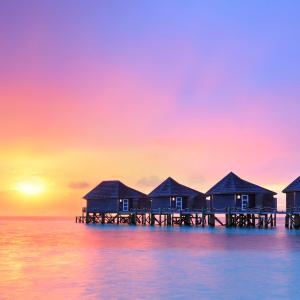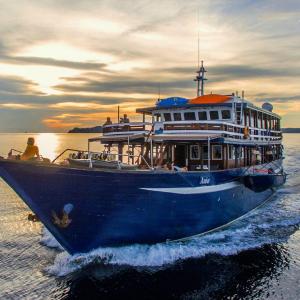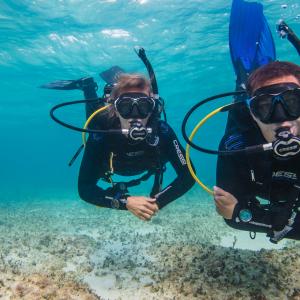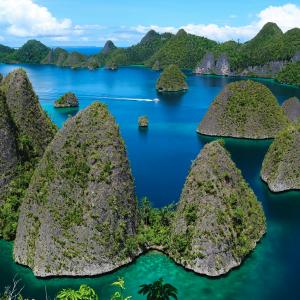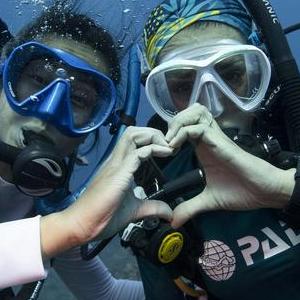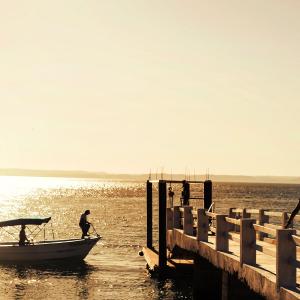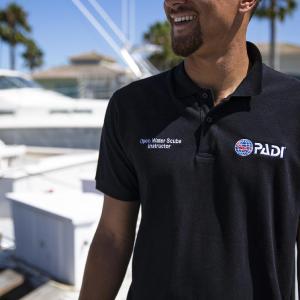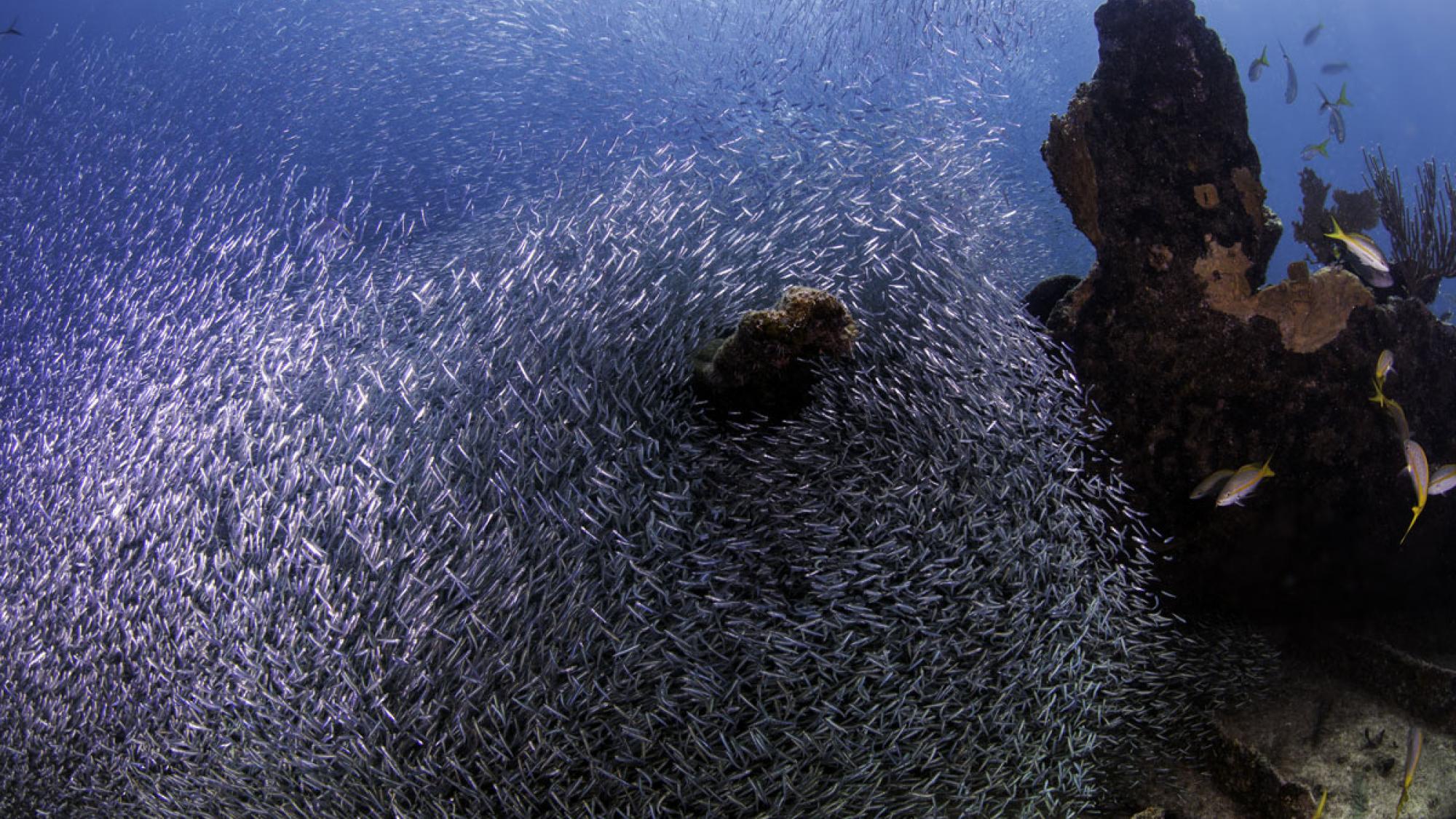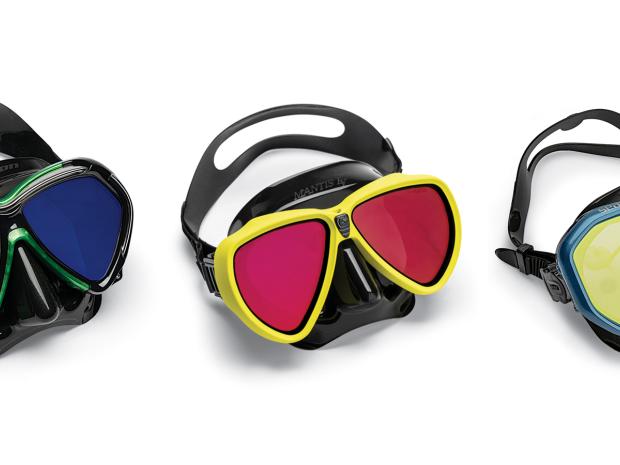America's funky dive archipelago harbors such an impressive fleet of scuttled shipwrecks it could make Truk Lagoon nervous. There are ships you've probably never heard of, and one you may even have watched sink on CNN. There are a handful you're sure to dive, and others you'll probably only dream about because of their abyssal depths and technical requirements.
Years of protection afforded by the creation of the John Pennekamp Coral Reef State Park in 1960 and the implementation of sanctuary preservation areas have helped preserve the Keys' reefs. The visible payoff to wreck divers is molasses-thick aggregations of fish on many ships, a density that will startle and amaze. You might almost be tricked into believing you are in the Caribbean, if it weren't for the billboards, fluttering Old Glories, and late-night convenience stores.
Spiegel Grove
The Spiegel Has Landed
BUILT: Pascagoula, Miss., 1956
LENGTH: 510 feet/155 meters
TYPE: Landing Ship Dock (LSD)
SANK: June 10, 2002
DEPTH: 60 to 130 feet/18 to 40 meters
SKILL: Intermediate to advanced
DIVE IT FROM: Key Largo, Tavernier or Islamorada.
COOL FACT: At the time of its sinking, the Spiegel Grove was the largest ship ever sunk to become an artificial reef.
IN A NUTSHELL: One word - huge. Its original stark battleship gray paint job has surrendered to a furry coat of red algae, and total reef-takeover is progressing rapidly. Barracuda, jacks, and silversides are already making this wreck their home base.
THE DIVE: If you watched CNN on May 17, you probably saw the naked hull of the Spiegel Grove floating upside down off Key Largo like a dead whale. Americans witnessed dive history on the tube in the following weeks: the sinking of the world's largest intentional artificial reef. Though some feel that measures should be taken to right the ship, it will probably forever lie on her starboard side. Penetration is strongly discouraged by dive operators. Though not yet cloaked by the same vibrant sponge and coral coat as the Duane and Bibb, a dive on the Grove is a study in size - you small, wreck big. Really, really big. A trip to the bow affords you a dreamlike view of a wreck appearing to cruise sideways out of the inky darkness. The giant anti-aircraft guns spring like goalposts from mid-decks, the gaping maw of the well-deck ramp is breathtakingly enormous, and the twin screws make excellent photo backdrops.
City of Washington
Remember the Maine?
BUILT: Pennsylvania, 1877
LENGTH: 320 feet/98 meters
BEAM: 38 feet/12 meters
TYPE: Steamship
SANK: July 10, 1917
DEPTH: 15 to 25 feet/5 to 8 meters
SKILL: Beginner
DIVE IT FROM: Key Largo
COOL FACT: When the battleship Maine (of "Remember the Maine" fame) exploded in Havana Harbor in 1858, the City of Washington was anchored right next door, close enough to be showered by shrapnel. The Washington crew helped in the Maine’s rescue effort.
IN A NUTSHELL: A scattered wreck-reef that contains substantial chunks of camouflaged fish-packed structure. Popular for fish feedings, the Washington can get crowded, which lowers the viz .
THE DIVE: One of Key Largo's most popular wreck-reefs, the City of Washington is, in places, barely discernible as a shipwreck. The hull, however, forms a reef ledge that harbors snappers and grunts and forms a nice backdrop for the frenzy of nurse sharks and barracuda looking for handouts in the nearby sandy plain.
The Benwood
Scattered, smothered, and covered
BUILT: England, 1910
LENGTH: 360 feet/110 meters
BEAM: 50 feet/15 meters
TYPE: Freighter
SANK: April 1942.
DEPTH: 25 to 40 feet/8 to 12 meters
SKILL: Beginner
DIVE IT FROM: Key Largo or Tavernier
COOL FACT: Running without lights to avoid attracting the attention of German torpedo salvoes, the Benwood slammed into the Robert C. Tuttle in '42 at the height of World War II.
IN A NUTSHELL: Popular shallow scattered wreck that's usually dived on the second tank after the Spiegel Grove. But with cargo holds full of fish life, it's no also-ran.
THE DIVE: One of Largo's most attractive wreck-reefs, the remains of the Benwood litter the shallows with sizeable structures including a nearly intact bow portion obscured by shiny curtains of reef fish. Beat the crowds here and you'll enjoy all of it in better visibility.
USCGC Duane
The Other Cutter
BUILT: Philadelphia, 1935-1936
LENGTH: 327 feet/100 meters
TYPE: "Treasury Class" cutter
SANK: Nov. 27, 1987
DEPTH: 60 to 120 feet/18 to 37 meters
SKILL: Advanced
DIVE IT FROM: Key Largo, Tavernier or Islamorada
COOL FACT: One of seven "327s"--a reference to the vessels' length--built in the 1930s and named after Treasury secretaries. Another is the nearby USCGC Bibb.
IN A NUTSHELL: A fully intact wreck that's swathed in a multicolored coat of encrusting sponge and pulsating fish life.
THE DIVE: When she was decommissioned in 1985, the Duane was the oldest active U.S. military vessel in history. The Duane and the Bibb were purchased by the Keys Association of Dive Operators (KADO) for a dollar apiece. The highly decorated vessel was a naked stark white when she was towed near Molasses Reef and sunk. All that has changed, and the Duane, sitting upright, awash in the steady flow of the Gulf Steam, is now decorated with sponges, corals, and intense fish life.
Eagle
Dutch Treat
BUILT: Holland, 1962
ORIGINAL NAME: Raila Dan
LENGTH: 269 feet/82 meters
TYPE: Freighter
SANK: Dec. 19, 1985
DEPTH: 70 to 110 feet/21 to 34 meters
SKILL: Intermediate to advanced
DIVE IT FROM: Islamorada, Tavernier or Key Largo
COOL FACT: The cavernous hull of the Eagle was split in two by Hurricane Georges in 1998.
IN A NUTSHELL: A great medium-depth two-part wreck that is listing slightly to starboard on a sandy bottom.
THE DIVE: The wreck lies within national marine sanctuary boundaries, and the two halves of the Eagle are popular not only with divers out of Islamorada and Tavernier, but with Keys fish as well, including tarpon and a large goliath grouper. The charges used to sink the vessel also blew diver-friendly penetration holes in its hull. Photo opportunities abound, including a crow's nest and a four-blade propeller.
Thunderbolt
When Lightning Strikes
BUILT: 1942
ORIGINAL NAME: USS Randolph
LENGTH: 188 feet/57 meters
TYPE: Cable Layer TYPE: Cable layer
SANK: March 3, 1986
DEPTH: 75 to 120 feet/23 to 37 meters
SKILL: Intermediate to advanced
DIVE IT FROM: Marathon
COOL FACT: This former Army vessel was used for lightning research, hence its name.
IN A NUTSHELL: The most popular wreck in the Middle Keys is this heavily encrusted former cable layer.
THE DIVE: Like most of the deeper Keys wrecks, you'll be asked to produce your C-card and log book to prove you can negotiate low vis and high current. Diving onto the bow, you'll find her cable-laying wheel, which has been fused in place by 16 years at the bottom. Barracuda and schools of jacks are docents on your wreck tour. Penetration of the wheelhouse and crew's quarters is possible. You can also swim up a staircase amidships and view the twin bronze propellers.
Cayman Salvage Master
BUILT: 1936
ORIGINAL NAME: F.V. Hunt
ALSO CALLED: Cayman Salvor, Cayman Salvager
LENGTH: 187 feet/57 meters
TYPE: Steel-hulled buoy tender
SANK: August 1985
DEPTH: 70 to 95 feet/21 to 29 meters
SKILL: Intermediate
DIVE IT FROM: Key West
COOL FACT: She transported Cuban refugees during the Mariel boatlift in the late '70s and early '80s, and was later seized by the U.S. government.
IN A NUTSHELL: Key West's most popular wreck dive draws a cloud of marine life including permit, Nassau grouper, reef octopus, and hawksbill turtles.
THE DIVE: Divers rejoiced that day in 1985 when the Cayman Salvage Master prematurely went down in just 90 feet/27 meters while being towed far offshore to create a sportfishing attraction in 300/91 meters feet of water. Though she sank on her port side, that same year, Hurricane Katrina picked it up and decided to make the Cayman Salvor upright. Today, it serves her original purpose (though not for anglers), attracting plenty of fish including goliath grouper, bar jacks, and silversides.
Adolphus Busch Sr.
This Wreck's For You
BUILT: Scotland, 1951
OTHER NAMES: London, Ocean Alley, Topsail Star, Windsor Trader
LENGTH: 210 feet/64 meters
TYPE: Freighter
SANK: Dec. 5, 1998
DEPTH: 50 to 105 feet/15 to 32 meters
SKILL: Advanced
THE DIVE: Big Pine Key, Key West, and most Lower Keys
COOL FACT: The Busch appeared in the 1957 film Fire Down Below, which starred Jack Lemmon, Robert Mitchum, and Rita Hayworth.
IN A NUTSHELL: Until the Vandenberg is sunk, the Busch will remain the Lower Keys' largest regularly dived wreck.
THE DIVE: The Looe Key Artificial Reef Association bought the Ocean Alley and towed it from Haiti to Miami. There, she was cleaned up, stripped of hatches and portholes and renamed after the beer magnate who helped fund the reef project. She's now sitting upright in the sand near Looe Key, clamped to the bottom by bow and stern anchors. Depth, lowered visibility and currents--though typically not as strong as other wrecks to the north--make this an advanced-only dive.
Joe's Tug
A Classic Key West Whodunit
LENGTH: 75 feet/23 meters
TYPE: Steel harbor tugboat
SANK: January 21, 1989
DEPTH: 50 to 60 feet/15 to 18 meters
SKILL: Intermediate
DIVE IT FROM: Key West
COOL FACT: Originally destined to sleep with the fishes off Miami, she sank under mysterious circumstances six miles south of Stock Island near Key West. Some say a rum-soaked local pirate did it.
IN A NUTSHELL: A very popular smaller wreck that is home to lots of fish.
THE DIVE: A great warm-up to diving some of the Keys' deeper wrecks, this tugboat is home to barracuda, angelfish, schoolmasters, and an occasional hawksbill turtle and jewfish. The currents and visibility can vary from calm and clear one day to swift and cloudy the next. Though missing the wheelhouse and prop, the Tug is largely intact, and full penetration is possible.
Having Trouble Finding Your Keys?
We'll Help Direct You to Your Perfect Island
A painless hour's drive south of Miami lands you on the first Key - Key Largo, America's most-visited dive destination. Many divers ask "why drive farther," throw the car in park and dive here. Continue southwest on U.S. 1 to Tavernier, however, and you'll find divers who prefer diving Largo's wrecks from a slightly less crowded key. Divers who dream of not only looking at fish but hooking them too drive to Islamorada, the undisputed epicenter of Keys angling. A convenient city in the heart of the Keys, Marathon offers a little bit of everything, while pastoral Bahia Honda boasts a beautiful state park with a nice stretch of beach. You'll be ordered to slow down while passing through Big Pine Key, as it is home to diminutive Key deer. If you're looking for a place that combines the peaceful world underwater with daiquiri-soaked nightlife above, look no farther than Key West. You can avoid the revelry, however, and check into a nice, quaint bed and breakfast.
Sinking Under Fishy Circumstances
One Man's Junk Is a Fish's Treasure
In addition to the usual suspects, you'll find a number of fish species on Florida Keys wrecks that may be slightly less common on its reefs:
GREAT BARRACUDA It's hard to dive the Keys without seeing a 'cuda, and you may actually encounter an entire school of them on a dive. Barracuda are the most common fish on the Duane and Bibb and second on the Thunderbolt.
FRENCH AND BLUESTRIPED GRUNTS Grunts are the John Does of the Florida Keys, and there's probably not a wreck you won't encounter them on.
BAR JACKS According to REEF, Bar Jacks are the most common fish species on the Eagle and Thunderbolt, second on the Bibb and third on the Duane.
GOLIATH GROUPER Once on the verge of extinction, these behemoths are making a comeback, and they love wrecks as much as we do.
More Must-See Keys Wrecks
ALEXANDER'S WRECK This 30-year-old wreck rests in less than 30 feet/9 meters of water off Key West. The 300-foot destroyer escort is split in two, attracting life big and small.
USCGC BIBB Less than a half-mile from the Duane lies one of her sister seven "327s"--the U.S. Coast Guard Cutter Bibb, built in the Charleston Navy Yard in 1935. Unlike the Duane, the Bibb is at rest on her starboard side in 95 to 130 feet/29 to 40 meters of water, making her slightly more challenging.
CANNABIS CRUISER Also called the "Pot Boat," this shrimper turned drug runner was scuttled as the Coast Guard closed in. Coming down off her high, she now rests in about 100 feet/30 meters of water off Islamorada, where thick schools of mangrove snapper and a huge jewfish populate the site.
HENRIETTA MARIE Discovered in the early '70s by Mel Fisher's treasure-hunting team, the Henrietta Marie is the oldest slave ship ever excavated. After forcibly relocating African captives to Jamaica for the slave trade, the British merchant ship was returning to London when it went down at New Ground Reef, 35 miles off Key West, loaded down with wood, cotton, sugar and, indigo.
HMS LOO It's believed that Loo hit its namesake reef on Feb. 5, 1744 when currents caught her and pushed her onto the reef, along with a ship she had captured, the Betty. Betty was originally a British ship that had been earlier captured by the Spanish.
NUESTRA SEÑORA DE ATOCHA Thirty miles west of Key West lies the object of Mel Fisher's 16-year obsession--the wreck of the 17th-century Atocha and her multimillion-dollar cargo of gold. He found the Spanish galleon in just 50 feet/15 meters of water. Occasional all-day trips depart Key West in summer to visit the treasure ship, which sank in 1622. The search and salvage operation cost Fisher more than just years--the tab included more than $10 million and three lives as well.
SAN PEDRO In 1733, a hurricane raked the Keys and dispatched this 287-ton Spanish galleon to the shallows off Islamorada. Now surrounded by a field of turtle grass, the remnants of the San Pedro - 90 feet/27 meters of ballast stones and red ladrillo galley bricks - share the sandy patch with a healthy population of marine life.
USS WILKES-BARRE If you think the Spiegel Grove is the Keys' largest wreck, you're wrong--the prize goes to the 610-foot Wilkes-Barre. Chances are, however, that you won't dive it during your Keys vacation, as it lies in 140 to 210 feet of water more than 15 miles southeast of Key West.
THE WINDJAMMER Built in Scotland in 1875, the 261-foot iron-hulled sailing ship ran aground on Loggerhead Reef in just 20 feet of water in 1907. This wreck-reef boasts star and brain coral mounds tended by Bermuda chub, grouper, yellow goatfish, and mangrove snappers.
Start your wreck diving adventure today.

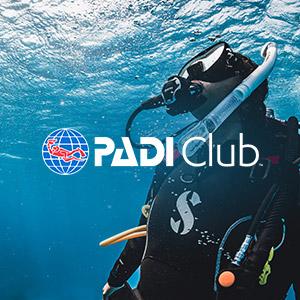
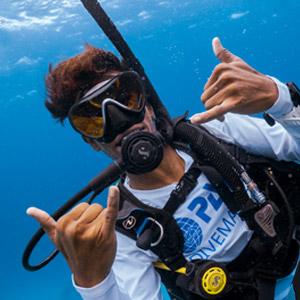

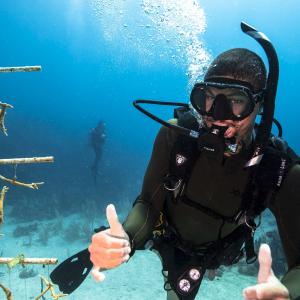
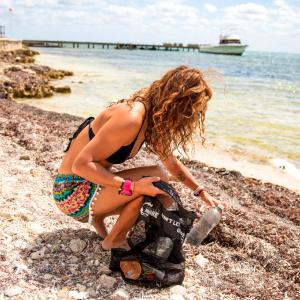

 해양 쓰레기
해양 쓰레기
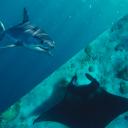 상어 및 가오리 보호하기
상어 및 가오리 보호하기
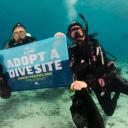 다이브 사이트 채택하기
다이브 사이트 채택하기
